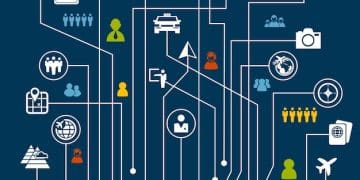Analyzing the Historical Roots of Income Inequality in the US in 2025

Analyzing the historical roots of income inequality in the US and its state in 2025 reveals a complex interplay of factors including policy changes, technological advancements, globalization, and shifts in social norms that have widened the gap between the rich and the poor.
Understanding the historical roots of analyzing the historical roots of income inequality in the US and its state in 2025 is crucial for shaping a more equitable future. Examining the trends that have led to the current situation can help policymakers and individuals alike work towards solutions.
The Gilded Age and the Rise of Inequality
The late 19th century, often referred to as the Gilded Age, marked a significant turning point in the trajectory of income inequality in the United States. This era witnessed unprecedented economic growth alongside vast disparities in wealth distribution.
Technological advancements and industrial expansion fueled immense fortunes for a select few, while a large proportion of the population struggled with poverty and limited opportunities.
Industrialization and Wealth Concentration
The rapid industrialization of the Gilded Age led to immense wealth accumulation in the hands of industrialists and financiers. This concentration of wealth created a significant divide between the wealthy elite and the working class.
Laissez-faire Policies and Limited Regulation
The prevailing laissez-faire economic policies of the time allowed for minimal government intervention in the market. This lack of regulation enabled businesses to operate with little oversight, contributing to exploitative labor practices and unchecked wealth accumulation.
- Exploitative Labor Practices: Low wages, long hours, and unsafe working conditions were common.
- Unfettered Wealth Accumulation: The absence of progressive taxation allowed wealth to concentrate rapidly.
- Limited Social Safety Nets: Minimal support for the unemployed, elderly, and sick exacerbated inequality.

The Gilded Age laid the foundation for persistent income inequality, with its legacy continuing to shape the economic landscape of the US. The policies and practices of this era contributed to a widening gap between the rich and the poor, a trend that has been difficult to reverse.
The New Deal and the Great Compression
The Great Depression of the 1930s brought about a dramatic shift in economic thought and policy. In response to widespread economic hardship, President Franklin D. Roosevelt introduced the New Deal, a series of programs and reforms aimed at alleviating poverty and stimulating economic recovery.
These policies played a crucial role in reducing income inequality and fostering a period known as the Great Compression.
Progressive Taxation and Wealth Redistribution
The New Deal implemented progressive tax policies that imposed higher tax rates on the wealthy. This revenue was used to fund social programs and infrastructure projects, redistributing wealth and narrowing the income gap.
Labor Rights and Collective Bargaining
The New Deal also strengthened labor rights, empowering workers to organize and bargain collectively. This led to improved wages and working conditions for many Americans, reducing income inequality.
- Social Security Act: Provided a safety net for the elderly and unemployed.
- Wagner Act: Protected workers’ rights to unionize and bargain collectively.
- Fair Labor Standards Act: Established minimum wage and maximum working hours.
The New Deal era demonstrated the potential of government intervention to reduce income inequality. By implementing progressive policies and strengthening labor rights, the US experienced a period of greater economic equality.
The Post-War Boom and the Rise of the Middle Class
The period following World War II was marked by unprecedented economic growth and the rise of a strong middle class in the United States. This era witnessed a significant reduction in income inequality and widespread prosperity.
Factors such as government spending, technological innovation, and expanding educational opportunities contributed to this economic boom.
Government Spending and Investment
Government spending on infrastructure, education, and research and development fueled economic growth and created jobs. The GI Bill, which provided educational benefits to veterans, played a crucial role in expanding access to higher education and creating a more skilled workforce.
Technological Innovation and Productivity Growth
Technological advancements, such as the development of the transistor and the rise of automation, led to increased productivity and higher wages. This benefited both businesses and workers, contributing to a more equitable distribution of income.
The post-war boom demonstrated the positive impact of government investment and technological innovation on reducing income inequality. By fostering economic growth and expanding opportunities, the US experienced a period of shared prosperity.
The Rise of Neoliberalism and Increasing Inequality
Starting in the 1980s, a shift towards neoliberal economic policies began to take hold in the United States. These policies, characterized by deregulation, tax cuts for the wealthy, and a decline in union membership, contributed to a significant increase in income inequality.
The consequences of these policies are still felt today, with the gap between the rich and the poor continuing to widen.

Deregulation and Financialization
Deregulation of the financial industry led to excessive risk-taking and financial instability. The financial sector grew rapidly, contributing a larger share of national income, with much of the gains accruing to a small elite.
Tax Cuts for the Wealthy and Reduced Social Spending
Tax cuts for the wealthy reduced the tax burden on the rich, while social spending was cut, leading to reduced support for low-income families. This combination of policies exacerbated income inequality.
- Decline in Union Membership: Weakening of unions reduced workers’ bargaining power.
- Globalization and Outsourcing: Shifting jobs overseas led to wage stagnation for many Americans.
- Technological Change: Automation and computerization replaced many middle-skill jobs.
The rise of neoliberalism marked a turning point in the trajectory of income inequality in the US. The policies implemented during this era contributed to a widening gap between the rich and the poor, reversing many of the gains made in previous decades.
Globalization and Technological Change in the 21st Century
Globalization and technological change have had a profound impact on the US economy in the 21st century. While these forces have brought many benefits, they have also contributed to increasing income inequality.
Understanding the complex interplay between these factors is crucial for addressing the challenges of income inequality.
Globalization and Trade
Globalization has led to increased trade and competition, which has benefited consumers but also put downward pressure on wages for many American workers. Outsourcing and the relocation of manufacturing jobs overseas have resulted in job losses and wage stagnation.
Technological Change and Automation
Technological change, particularly automation and artificial intelligence, has led to the displacement of many workers, particularly those in routine and middle-skill jobs. This has created a “skills gap,” with many workers lacking the skills needed to succeed in the modern economy.
Globalization and technological change have presented both opportunities and challenges for the US economy. While these forces have driven innovation and economic growth, they have also contributed to increasing income inequality.
Income Inequality in the US: State in 2025 and Future Outlook
As we look towards 2025, the issue of income inequality in the US remains a critical concern. The trends that have contributed to the widening gap between the rich and the poor are likely to persist, unless significant policy changes are implemented.
The future outlook for income inequality in the US depends on a variety of factors, including policy choices, technological developments, and social attitudes.
Projected Trends and Challenges
Economists project that income inequality will continue to rise in the coming years, driven by factors such as globalization, technological change, and the decline in union membership. This trend poses significant challenges for American society, including increased social unrest, reduced economic mobility, and slower economic growth.
Policy Recommendations and Potential Solutions
Addressing income inequality will require a comprehensive set of policy solutions. These could include raising the minimum wage, strengthening labor rights, investing in education and job training, implementing progressive tax policies, and expanding access to affordable healthcare and housing.
The future outlook for income inequality in the US is uncertain. However, by implementing bold and comprehensive policy solutions, it is possible to create a more equitable and prosperous society for all Americans.
| Key Point | Brief Description |
|---|---|
| 💰 Gilded Age | Industrialization and laissez-faire policies fueled wealth concentration. |
| 🤝 New Deal | Progressive taxation and labor rights reduced inequality. |
| 📉 Rise of Neoliberalism | Deregulation and tax cuts led to increasing inequality. |
| 🌐 Globalization & Tech | Globalization and technology present both opportunities and challenges. |
FAQ
▼
The Gilded Age saw rapid industrialization, which concentrated wealth in the hands of a few while labor practices exploited workers. Laissez-faire policies also meant minimal government intervention, exacerbating the wealth gap.
▼
The New Deal implemented progressive tax policies, increasing taxes for the wealthy. It also strengthened labor rights, allowing workers to organize and bargain. These initiatives reduced income inequality during the era.
▼
Neoliberalism involves deregulation, tax cuts for the wealthy, and reduced union power. These policies increased income inequality by allowing financial instability and reducing support for low-income families.
▼
Globalization has increased competition and lowered wages for some workers, while technological change fuels automation, displacing jobs. These forces create a skills gap, benefiting higher-skilled workers more.
▼
Potential solutions include raising the minimum wage, strengthening labor rights, investing in education, promoting progressive taxation, and increasing affordable healthcare. These initiatives aim to reduce wealth disparities and foster economic mobility.
Conclusion
Analyzing the historical roots of income inequality in the US reveals a complex interplay of economic policies, technological advancements, and social changes. Addressing this issue in 2025 and beyond requires a comprehensive approach that combines policy reforms with investments in education and job training, ultimately fostering a more equitable and prosperous society.





